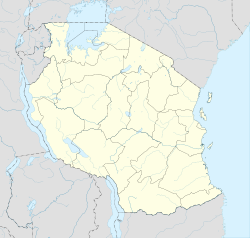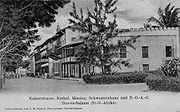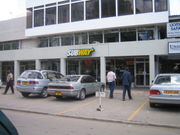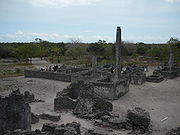
Dar es Salaam
Background to the schools Wikipedia
SOS Children, an education charity, organised this selection. With SOS Children you can choose to sponsor children in over a hundred countries
| Dar es Salaam | |
|---|---|
| — City — | |
| Dar es Salaam city centre moments before dusk | |
|
|
|
| Coordinates: 6°48′S 39°17′E Coordinates: 6°48′S 39°17′E | |
| Country | |
| Districts |
List
|
| Government | |
| • Mayor | Adam Kimbisa |
| AreaRegion/Province | |
| • City | 1,590.5 km2 (614.1 sq mi) |
| • Water | 0 km2 (0 sq mi) |
| Population (2002) | |
| • Metro | 2,497,940 |
| Time zone | GMT +3 |
Dar es Salaam (Arabic: دار السلام [translation: "house of Peace"] Dār as-Salām), formerly Mzizima, is the largest city in Tanzania. It is also the country's richest city and a regionally important economic centre. Dar es Salaam is actually an administrative province within Tanzania, and consists of three local government areas or administrative districts: Kinondoni to the north, Ilala in the centre of the region, and Temeke to the south. The Dar es Salaam Region had a population of 2,497,940 as of the official 2002 census. Though Dar es Salaam lost its official status as capital city to Dodoma in 1974, it remains the centre of the permanent central government bureaucracy and continues to serve as the capital for the surrounding Dar es Salaam Region.
History
In 1859, Albert Roscher of Hamburg became the first European to land in Mzizima ("healthy town"). In 1866 Sultan Seyyid Majid of Zanzibar gave it its present name, an Arabic phrase meaning house of Peace. A popular but erroneous translation is "haven of peace" resulting from a mixup of the Arabic words "dar" (house) and "bandar" (harbour). Dar es Salaam fell into decline after Majid's death in 1870, but was revived in 1887, when the German East Africa Company established a station there. The town's growth was facilitated by its role as the administrative and commercial centre of German East Africa and industrial expansion resulting from the construction of the Central Railway Line in the early 1900s.
German East Africa was captured by the British during World War I and from then on was referred to as Tanganyika. Dar es Salaam was retained as the territory's administrative and commercial centre. Under British indirect rule, separate European (e.g. Oyster Bay) and African (e.g. Kariakoo and Ilala) areas developed at a distance from the city centre. The town's population also included a large number of South Asians.
After World War II, Dar es Salaam experienced a period of rapid growth. Political developments, including the formation and growth of the Tanganyika African National Union (TANU), led to Tanganyika attaining independence from colonial rule in December 1961. Dar es Salaam continued to serve as its capital, also when in 1964 Tanganyika and Zanzibar merged to form Tanzania. However, in 1973 provisions were made to relocate the capital to Dodoma, a more centrally located city in Tanzania's interior. The relocation process has not yet been completed, and Dar es Salaam remains Tanzania's primary city.
One of the deadly 1998 U.S. embassy bombings occurred in Dar es Salaam; the other was in Nairobi, Kenya.
Geography
Dar es Salaam is located at 6°48' South, 39°17' East (−6.8000, 39.2833). The city is situated on a massive natural harbour on the Eastern Indian Ocean coast of Africa.
Administratively, Dar es Salaam is broken into 3 districts: Ilala, Kinondoni, and Temeke.
Climate
Being situated so close to the equator and the warm Indian ocean, the city experiences generally tropical climatic conditions, typified by hot and humid weather throughout much of the year. Dar es Salaam features a tropical wet and dry climate, with two different rainy seasons. Annual rainfall is approximately 1,100 mm (43 in) and in a normal year there are two distinct rainy seasons: "the long rains", which fall during April and May, and "the short rains", which fall during October and November.
| Climate data for Dar es Salaam | |||||||||||||
|---|---|---|---|---|---|---|---|---|---|---|---|---|---|
| Month | Jan | Feb | Mar | Apr | May | Jun | Jul | Aug | Sep | Oct | Nov | Dec | Year |
| Source: MSN Weather | |||||||||||||
Population
Dar es Salaam is the largest city in Tanzania with 2.8 million people. With a population rate increase of 4.39% annually the city has become the 3rd fastest growing in Africa (9th fastest in the world) after Bamako and Lagos, respectively. The metro population is expected to reach 5.12 million by 2020.
- 1925: 30,000
- 1948: 69,000
- 1957: 129,000
- 1972: 396,000
- 2005: 2,456,100
- 2010: 3,000,000 (Rounded Estimate)
Economy and infrastructure
Dar es Salaam is Tanzania's most important city for both business and government. The city contains unusually high concentrations of trade and other services and manufacturing compared to other parts of Tanzania, which has about 80 percent of its population in rural areas. For example, about one half of Tanzania's manufacturing employment is located in the city despite the fact that Dar holds only ten percent of Tanzania's population. Located on a natural harbour on the Indian Ocean, it is the hub of the Tanzanian transportation system as all of the country's main railways and several highways originate in or near the city. Its status as an administrative and trade centre has put Dar es Salaam in position to benefit disproportionately from Tanzania's high growth rate since the year 2000 so that by now its poverty rates are much lower than the rest of the country. The Benjamin William Mkapa Pension Tower with more than 21 stories is the tallest building in the city and the country.
Air Tanzania, the national airline, has its head office in Dar es Salaam.
Transportation
The Julius Nyerere International Airport is the principal airport serving the city, named after the country's first President. There is also a railway infrastructure (TAZARA) connecting the coastal town of Dar es Salaam to the neighbouring country of Zambia on its western border.
Culture
Downtown Dar es Salaam includes many small businesses, many of which are run by traders and proprietors whose families originated from the Middle East and Indian sub-continent - areas of the world with which the settlements of the Tanzanian coast have had long-standing trading relations. During the daytime the heavy weight of traffic, office workers, busy merchants, street vendors and restaurateurs of the area lend it a frenetic and slightly claustrophobic air. However, after nightfall the area is relatively quiet as much of the city's nightlife is located in more residential districts away from the city's mainly commercial centre.
The sprawling suburbs furthest from the city centre are generally populated by Tanzanians of African descent, with the exception of Oyster Bay, where there is a large population of foreign expatriates. Although there is no racial hostility, the various ethnic communities of Dar es Salaam do not tend to mix heavily. The edges of Dar es Salaam are spreading rapidly, severely taxing the transportation network (which aside from ferries, lacks any kind of mass transit facilities) and raising the prospect of future urban overcrowding.
Due in part to the growth of the expatriate community and the increasing importance of tourism, the number of international restaurants has risen very rapidly over recent years. The city now offers a surprisingly rich and internationalised diversity of cuisine, ranging from traditional Tanzanian barbecue style options such as "Nyama Choma" (roasted meat) and "Mishkaki" ( Shish Kabob - usually barbecued and served with salt and various hot peppers on the side) and the long-established traditional Indian and Zanzibari cuisine, to options from all corners of the globe including, Chinese, Thai, Turkish, Italian, and Japanese food.
There is also a lively music scene in Dar es Salaam which is divided among several styles. The longest standing segment is live dance bands such as Kilimanjaro, Twanga Pepeta and FM Academia. Taarab which was traditionally strong in Zanzibar has also found a niche but remains small compared both to dance music and " Bongo Flava", a broad category that represents the Tanzanian take on Hip Hop and R&B, which has quickly become the most popular locally produced music. This type of music is especially strong among the youth and it seems that its pull is reducing the interest in performing and hearing dance music. Songs by artists such as Ferooz name check Dar districts such as Sinza. Traditional music, which locally is used to refer to tribal music is still performed but typically only on family oriented occasions such as weddings.
Much like the popular music of other major cities Dar es Salaam's hip music of the day Bongo Flava is a cultural escape for youths that speaks to topics of everyday life such as "HIV/AIDS, scraping a life together, the difficulty of meeting basic needs, class and wealth barriers, holding your head high despite everything."
This Rap scene has been present and growing for the past ten years as City life has drawn much of the youth in surrounding areas have made the trek into a more urban lifestyle in search of a new better beginning.
In the 1970s the Ministry of National Youth Culture aimed to create a national culture, which stressed the importance of music. Dar es Salaam became the new music center in Tanzania, with the local radio exposing new bands and dominating the music and cultural scene. With this ujamaa, or family, mentality governing culture and music a unified people’s culture was created. Dar es Salaam became a centre of city crime, gangs, and violence, which lead to the rise of hip hop music. Throughout the years, the radio in Dar es Salaam has played a major role in the dissemination of music because many people don’t have televisions and cassettes are used over CD’s. In addition, creating music in Dar es Salaam involves significant dedication because artists receive little pay due to inadequate copyright laws.
A variety of museums, including the National Museum, the Village Museum and the Botanical Garden are all very close by.
Within an hour's drive north is Bagamoyo, which is home to the Kaole ruins. There are beaches on the Msasani peninsula north of Dar es Salaam and in Kigamboni to the south where residents and tourists alike frequently visit. Trips to the nearby islands of the Dar es Salaam Marine Reserve are a popular daytrip from the city and a favourite spot for snorkeling, swimming and sunbathing. The National Stadium hosts Dar es Salaam's Young Africans Football Club, Simba football club, Other Tanzanian football clubs, and many other international matches.
The first cineplex in Tanzania to show first-run Western and Indian releases was opened in Dar es Salaam in December 2003.
Globalization
Globalization has affected many of the cultural expressions in Dar es Salaam, in particular, hip hop music and culture. The hip hop scene in Dar es Salaam articulates a blending of local cultural struggles and the indigenization of global influences. Hip hop music and culture arrived in Tanzania, taking its cues from various African American styling. Birgit Quade highlights Tanzanian hip hop’s connection to US culture when she writes: “What makes hip-hop a global phenomenon is that its draws upon style, music, and look that is not restricted to any local region or language…In the mid-1980s, young people who saw the first hip-hop films and videos coming from America and started break-dancing and rapping.” The adaptations of language, fashion, style, and content within Tanzanian hip hop culture have evolved gradually. The result of this evolution has created a localized form of hip hop, often showcasing native dialectic lyrical performances and traditional garbs. While hip hop in Dar es Salaam is a clear reflection of Tanzanian localized struggle and culture, it also engages in and compromises with aspects of Western culture. Also, a former University of Connecticut Huskies basketball player, Hasheem Thabeet, a basketball player who was drafted 2nd overall by the Memphis Grizzlies of the National Basketball Association in the 2009 NBA Draft is from here.
Education
Dar es Salaam is also the educational centre of Tanzania. The city is home to University of Dar es Salaam, Ardhi University, Muhimbili University of Health and Allied Sciences (MUHAS), the Open University of Tanzania, the Hubert Kairuki Memorial University (HKMU) as well as the International Medical and Technological University (IMTU). Other institutes of higher education include the Institute of Financial Management (IFM), Dar es Salaam Institute of Technology (DIT) and the College of Business Education (CBE).
Dar es Salaam also boasts some of the finest schools in Tanzania. The following are schools that provide secondary education, O Levels and A Levels in Tanzania, according to the National Examination Council Of Tanzania (NECTA) syllabus.
Private secondary education schools include Al Muntazir Islamic Seminary, The Ali Hassan Mwinyi Elite School, Agakhan Mzizima Secondary School and Shaaban Robert Secondary School. It has the famous Indian school where CBSE Foreign is taught up to 12th standard. The children of many Indian expatriates that work in Dar study in this school.
Some of the International Schools in Dar es Salaam are the International School of Tanganyika (IST), Haven of Peace Academy (HOPAC), Dar es Salaam International Academy (DIA), Dar es Salaam International School (DIS), and Laureate.
Suburbs
- Masaki is a posh suburb within the Kinondoni district of the region. Many diplomats reside in this area. Masaki has been plagued by water shortages since 1998. Residents buy water from tankers. The area is well known by Safari Rally Fans for its rough roads and is mostly forest with scattered villages. The majority of the population is comprised of Muslims.
- Mikocheni is a suburb and administrative ward in the Kinondoni district of the Dar es Salaam Region of Tanzania. According to the 2002 census, the ward has a total population of 27,283.
- Msasani is a peninsula to the northeast of the city centre. It's home to many of the expatriates from Britain and other western countries that live in Dar es Salaam. Msasani contains a mixture of traditional shops and western-oriented resorts and stores.
Notable people
- Hasheem Thabeet – Memphis Grizzlies basketball centre
- Marin Hinkle - Actress, Two and a Half Men TV Show
- Nairn McEwan, Scotland rugby union player and second national coach was born in Dar es Salaam.
Partner Cities
 Samsun, Turkey
Samsun, Turkey













